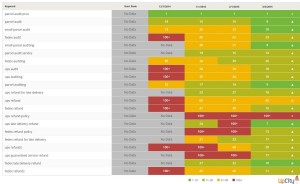
We have always instinctively appreciated brilliant design, whether in physical objects or digital products, but until recently there was relatively little recognition of the business value of design. That’s changing. Design is now increasingly seen as a differentiator and growth driver, and great user experience correlates with better business performance. Digital transformation specialists have responded to the potential opportunity in design-driven growth by broadening their approach to UX.
There are many facets of design to consider when developing or transforming a design, so no matter how experienced we are as UX engineers, there is always room for improvement. In order to increase peak performance in UX, it’s important to keep honing those design skills. At Infostretch, we keep these eight design principles front of mind to challenge ourselves to continuously innovate UX.
- Data should underpin design decisions
When product teams want to find answers to the “Why?” and “What?” questions, data-informed decision-making has the answers. Not only does a data-informed approach to fundamental or strategic design decisions yield better performance, but it often results in more innovative outcomes. For instance, studying user behavior patterns enables design teams to create more tailored products based on that information. Qualitative research also plays an important role in finalizing designs.
- Put the user at the center of your design methodology
A dynamic approach to UX should encompass a deep understanding of the users, information architecture and visual design, while testing the product all the way through the lifecycle with the twin goals of meeting the users’ needs and doing so elegantly. With the right UX methodology, users are at the center of the design and development process in an iterative cycle of research, design and evaluation. Along the way, designers will encounter complex scenarios, which, using the right methodology, can be handled efficiently. Many organizations create their own methodology to suit their user needs. It’s important to make sure that these are aligned with modern design approaches.
- Prioritize multi-disciplinary approaches
Look closely at any successful product, and behind it you will see team members whose design knowledge spans many areas of business, like strategy, marketing, storytelling, analytics, and more. Creating multi-disciplinary teams is an important principle that results in improved UX. Team members bring different knowledge and awareness to the table and while incorporating their views can take longer, the end result is better.
- Scrap the jargon
Most people don’t use the technical terms that we use in UX design. They haven’t heard of heuristics or phenomenology and, to be honest, they really don’t care much either. Those kinds of term are fine within the UX team but when you’re communicating with the rest of the organization, stick to language that is clear and understandable to all.
- Revisit past insights
Past projects are repositories for many valuable insights and ideas. It’s easy to forget the details once a project is finished. However, designers benefit from reviewing those projects. It’s useful to refamiliarize yourself with the main insights, what was done in response to those insights, and check whether it is being done now. A meta-analysis of multiple projects can form the basis of a good practice guide that can be used both internally and externally.
- Fearless design drives innovation
UX can create wonders when designers adopt skills from different domains. Because every UX problem is unique, this lateral thinking can provide a differentiated approach.
- Make it accessible
Accessibility is probably one of the most overlooked aspects of user experience design and especially mobile UX design. 15% of the world’s population experiences some form of disability. The Web Content Accessibility Guidelines is a freely available resource, and for digital designers, is a “must have” part of their toolbox.
- Keep design assets close at hand
Every organization, irrespective of its size, needs quality assets to create effective and aesthetic design. Fully customisable assets are indispensable, whether in the form of icons, vector graphics, images, architectures, wireframe formats or even in form of designed screen. They’re easily available from different subscriptions and save a lot of time in the design process.
Digital & Social Articles on Business 2 Community
(21)
Report Post





